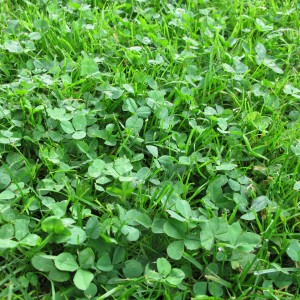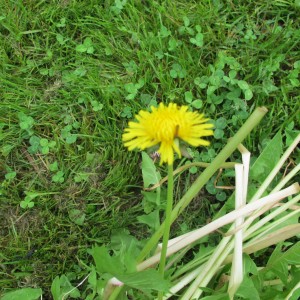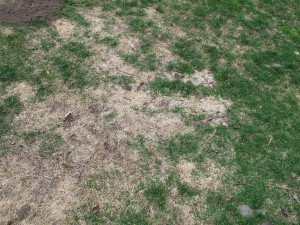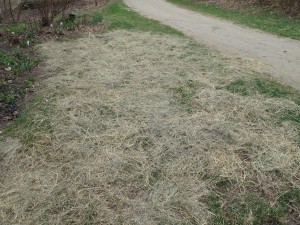Spring Lawn Care
I love lawns. Not big lawns, and they don’t need to be pure Kentucky bluegrass, either. I love a little bit of mowed green that has some grass and clover; it can have a few dandelions or bluets or violets, too. I can live with Creeping Charlie (also called ground ivy or by its scientific name, Glechoma hederacea). Overall my philosophy is this: if it’s green and you can mow it, it’s a lawn. Only thistles and other sharp things need to be dug out- but never nuked with chemicals.
Despite that philosophy, people often remark on how lush and thick my lawn is, and how nice it feels underfoot. Having a nice lawn is easy if you follow a few simple rules.
First, stop worrying about it. And certainly never add any chemicals to it. Weed-‘n’-feed formulas kill off not only the broad-leafed plants like dandelions, they also diminish the biological activity in the soil. I want a healthy soil full of microbes (including bacteria and fungi) and know that many microbes are killed or adversely affected by chemicals.
Chemical fertilizers are made of salts of nitrogen, phosphorus and potassium. These have the ability to dry out and kill microbes. And of course if your product includes chemicals for killing moss, weeds, fungi or insects, all those chemicals add to the killing power. Your soil cringes when you load up the spreader with weed-‘n’-feed.
If you want to have a good healthy lawn, you need good healthy soil. It needs about 6 inches of reasonably good soil that drains well (so as not to drown the lawn grasses) but is not so sandy that it dries out in an afternoon. Cut and peel back a one-foot square piece of sod after a rainstorm, and look at the soil. Grab a handful of soil. Does it form a cylinder in your hand when you squeeze it, and hold its shape when you open your fingers? If so, you have clay, or a clay-based soil.
If you perform the squeeze test on sandy soil, it will crumble apart when you open your fingers. When you rub the soil between your fingers, you will feel sharp grains of sand. But if you have a nice loam, the soil with be dark and the cylinder will fall apart if you touch it with a finger.
If you are not happy with your lawn, I suggest getting your soil tested. The Extension Service in most states will have on-line instructions on how to take a soil sample, and where to send it. Some garden centers have kits for sale. Find out what kind of soil you have, what it needs, and if your soil pH is in the right zone.
Soil pH is a measure of how acidic or alkaline your soil is. Lawns do best when the soil pH is near neutral (which is 7.0) or slightly acidic. Our rain is acidic, and neglected soils – including most lawns – have soil that is pretty acidic. You can fix this easily by adding limestone to the lawn, and a pH test will tell you how much to add to balance it out. If your soil is too far from neutral, some soil minerals will become unavailable to the grass plants, even if the minerals are there. You can add limestone at any time, though most lawn experts recommend the fall so that it will have time to do its work before spring growth begins.
The other additive that helps an anemic lawn is compost or organic matter. Good crumbly compost can be flung around the lawn with a shovel and then raked out to provide even coverage. Doing that now would help. Earthworms in a healthy lawn will be more than willing to eat that compost and then excrete the nutritious ingredients into the soil.
Earthworms, fungi and bacteria will also help you improve your lawn by breaking down your grass clippings. Those clippings will add organic matter and enrich your soil. So cut your lawn regularly – avoiding a thick layer of clippings that needs to be bagged or raked.
Lawn height is critical for a good, easy-care lawn. Get out of the golf course mindset. This is a lawn, not a putting green! I set my mower, generally, one notch down from the highest setting. Right by the front door I keep it a little shorter at times.
Why keep your lawn long? Your lawn is made of millions of plants, and each one can only create a healthy root system if you let it have enough blade to create its own food by photosynthesis. Too short? The roots will be stunted, and the lawn will not be healthy. And the taller the grass, the more it can shade out annual weeds and crabgrass.
Think about it: if there were daffodils that we could mow down only to have them bloom again, we would pay big bucks for them. But call those yellow flowers dandelions, and it’s war. I hope you’ll re-think your position about lawn chemicals if you’re in the weed-‘n’-feed school. Diversity of plant types in the lawn helps to create a lush, lovely green space.
Henry Homeyer is a garden designer and the author of 4 gardening books and a children’s chapter book. His Web site is www.Gardening-Guy.com.
Spring Lawn Care
It’s time for a little lawn care. I’m not obsessive about my lawn, but I like a nice green swath between the flower beds that is suitable for badminton, croquet or general lounging. It need not be Kentucky bluegrass, and certainly should have some dandelions, those cheerful harbingers of warm days and blue skies. For me, if it’s green and I can mow it, it’s a lawn.
Right now my lawn is not all green. Not by a long stretch. My household includes 3 dogs, and they have killed a fair amount of grass right outside the front door. And then there are the moles out back that have been excavating their own Big Dig much of the winter.
Dead spots and thin spots need to be seeded, and the ground is warm enough now to do that. I use a “conservation mix” because it is full of good tough varieties that can take a beating more than one that is largely Kentucky bluegrass. And diversity is good for minimizing disease problems.
For large dead spots I take a short-tined garden rake and rake the dead grass out, roots and all. Then I spread half an inch of good compost over the area and scratch it into the top inch or so with a rake. I broadcast a fairly dense sprinkle of seed (by hand), then use a lawn rake to mix the seed into the top quarter inch. I do this by flipping over the rake and dragging the long tines over the soil – upside down. That lightly buries the seed, though there is always still seed visible. Grass seed doesn’t need much soil cover, if any. Lastly, I spread a little mulch hay or straw over the top – just enough to shade the soil and keep it from drying out.
In some areas the grass is growing but is sparse, or contains some dead grass. There I briskly rake the lawn using a bamboo or metal awn rake to remove the dead grass as much as possible. Next I spread some compost with a shovel and even it out with my rake. Then I “overseed” the lawn with seed, just sprinkling it by hand (though I suppose you could do it with a seed spreader). I don’t spread straw on the overseeded places, as there is enough existing grass to provide shade. Generally the soil stays damp at this time of year, too.
You may have noticed that I did not mention adding fertilizer to the lawn. My soil is pretty good because I don’t collect my grass clippings when I cut the lawn, and I do not add any herbicides or insecticides to kill weeds or bugs. Chemicals of any sort, even chemical fertilizer, inhibit the growth of beneficial bacteria and fungi in the soil. My “lazy” way of dealing with the lawn helps me to have biologically active soil, one rich with microorganisms that break down grass clippings, enriching the soil. Earthworms are a big help, too, aerating the soil and fertilizing the soil with their castings.
If you feel you must add fertilizer to the soil, choose an organic one. Instead of chemical salts that can harm beneficial microorganisms, an organic fertilizer has naturally occurring ingredients like ground oyster shells and peanut hulls, chicken manure and seaweed. Chemical fertilizers can dissolve and disappear in a week of rain, but the ingredients of organic fertilizers won’t.
Want to minimize crab grass? Corn gluten contains a protein that reduces germination of weed and crabgrass seeds in the lawn. It is usually sold at feed-and-grain stores or garden centers in 50-pound bags. You can’t apply it when you seed your lawn, as it would affect good grass seeds, too. But it’s not a miracle. It will reduce germination, but it doesn’t kill weeds or their seeds.
I’m told that corn gluten works best when applied 3 years in a row. And one last benefit: it also acts as an organic fertilizer that contains about 10% nitrogen by weight, breaking down and releasing the goodness slowly. This is the time of year to spread corn gluten – though I must admit, I never have.
About those moles: they seem to do most of their excavation in the fall and winter, leaving piles of nice soil on the lawn. I just rake that soil onto a wide shovel, collect it in my wheelbarrow, and then add it to raise beds elsewhere, or to fill in depressions.
Moles can be repelled with castor-oil based solutions. I used to make my own, but all castor oil at the pharmacy seems to be the new, better, more modern “good tasting” kind. But garden centers still sell mole repellents made with castor oil, and though I haven’t tried them, they should work just fine.
And what about moss? I ignore it. It generally grows in shady areas that are acidic. If you don’t like it, rake it out and plant seed designated for shady areas. But first add some limestone and compost to sweeten the soil and improve the soil. On-line I read about a moss killer that promises “one application will kill moss for a year”. That makes me shudder when I think about my dogs walking on that soil, were I to apply it – which I will not!
So go out and enjoy the sun. And remember that setting the blades of your lawnmower to 3 inches will help your grass have more energy and will help to shade out crabgrass and weeds.
Henry’s Web site is www.Gardening-guy.com. See past columns there or search for answers to gardening questions.







